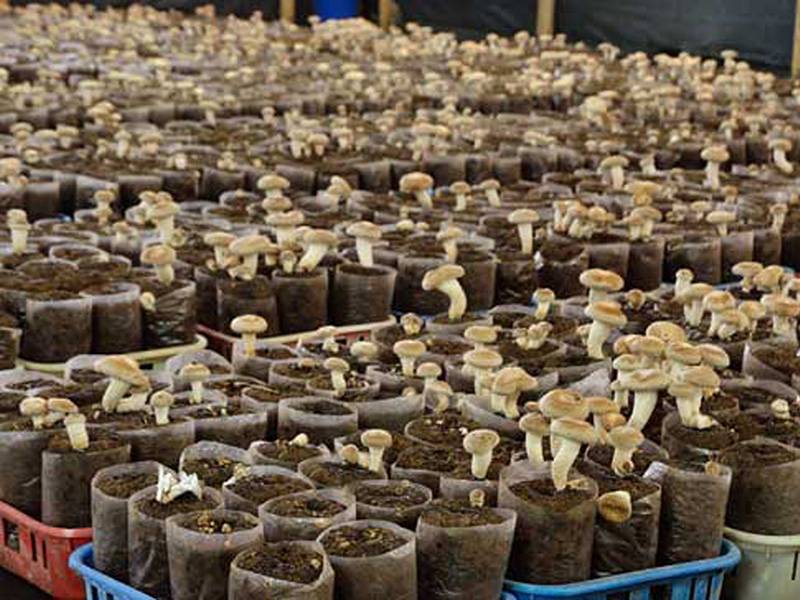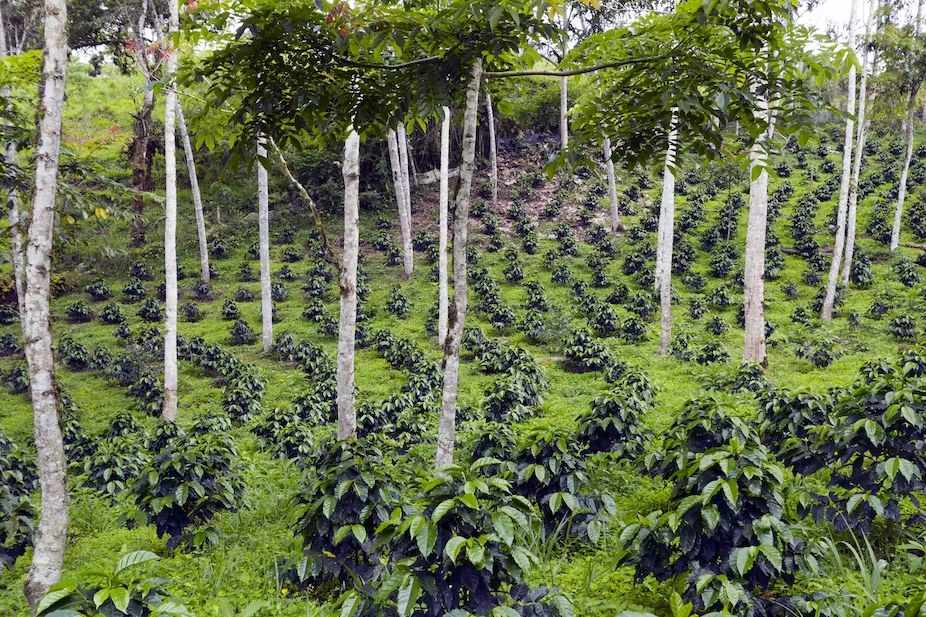“Worlds Like 'Resilience, Circular and Regeneration' are not Ideologies but Critical Design Approaches”

For many people today, recycling is downcycling, and the way we design products greatly dictates much of their changing process. Regeneration is a key design feature of the biosphere as planet earth has always operated on an upcycling basis. Vincent Walsh (pictured on the right) is the Founder and CEO of RegenfarmCo, a regenerative agriculture platform, Mycoloops, a circular mushroom company and Herblabism, a plant-based food company. Focused on turning coffee grounds into mushrooms, he designs agro-forestry models and supplies conferences with plant-based and sustainable food. We spoke to him about innovative models in Food & Beverage (F&B) management for the MICE industry.
How do you integrate regenerative and circularity elements in your projects?
All my work is interconnected by regenerative and circular food infrastructures. Regenerative is all about what happens at the very beginning of the farm: How do you create farming systems that put more carbon in the soil, increase site biodiversity and enable better water infrastructure?... in order to get more sustainable, adaptable and greener systems. Driving innovation at the beginning of the supply chain, particularly in food and agriculture, is critical − the more innovation at this point supports further innovation opportunities throughout the supply chain. Enhancing the value of organic food by minimising any waste. The circularity part is what happens to the food when it leaves the farm. When investing in your agricultural infrastructure, the first thing you’ll want to do is make sure that by having a farm surplus, you can retain that food in the most sustainable way. To be used in processes such as fermentation and dehydration. Circularity is also what happens at the end of a supply chain, allowing for more innovation on waste − upcycling rather than downcycling or recycling. Products like coffee waste can be turned into mushrooms, or even use that waste as compost. We need a whole range of different ways of looking at our infrastructure.
How can we initiate such a process with association meetings in the events industry?
There will always be an opportunity to act more locally within each event. What we’re trying to do in the UK is hyper localise everything − identify the venue roadmap and then link them to surrounding land and farms in order to create new supply platforms. A biological network of integrated farms, developing open logistics for various events and connecting them to various food sources. I think design is a really important discussion to have, feeding into different approaches to include planning as a key part of our strategies. Creating a resilient, hyper-localised and regenerative event requires considerable planning. Obviously, F&B is a highly important part of it. In a recent survey, over 60% of delegates and conference organisers said that F&B was the most important aspect of an event. I also think infrastructure is an interesting part. For example, at Fira Barcelona, all those materials such as plastic, carbon booths and stands could be looked at continuously for new purposes, turning their process within the venue into a bottom-up cycle. Every tradeshow needs a dedicated sustainability team working with all the traders to better manage the resources that come through the doors, and make sure they are hyper-localised. These are the standards we expect from convention centres when they host our shows.

Coffee bushes in a shade-grown plantation in the Andes, Ecuador. Morley Read/Shutterstock
Explain to us your innovative process of growing mushrooms from coffee grounds at Mycoloops?
I have often said that what we are doing here is "going back to the future". When I was a young boy, my family wasted absolutely nothing and a lot of the waste went back into our garden. We're not doing anything new here. Even the kind of food systems I'm designing - agroforestry, forest gardening, etc - are ancient systems, developed in places like Ethiopia, Nigeria, even South America, thousands of years ago. Everything we use is what Nature gives us, in different layers to grow different foods. One of the most popular mushrooms in the UK is oyster mushroom, and the reason beyond its nutritional value is because it grows quite well in our temperate climate. In fact, this mushroom is the fastest decomposer of wood. When a tree begins its dying process, the first reaction it indicates to the forest is a drop in temperature - this is when the mushrooms will be attracted to the tree, particularly these oyster mushrooms. The second major indicator is when the tree falls. In a forest system there are usually two ways to trick a mushroom into appearing: when the tree falls what happens is that the mushroom starts eating the tree, turning the woody matter into soil. But let's say we don't use wood; we try another way and inject oyster spores into the coffee, or into a piece of wood. What we can do is, at the right time, pull the tree into the water for 48 hours, bringing the temperature down in a similar way to a forest system. Once it's taken out of the water, the fungus process begins. My entire mushroom infrastructure starts from waste streams like coffee grounds that generate edible mushrooms. Why is this important? First, because if coffee waste is in the earth field, it releases 20 times more methane than carbon dioxide. Also, if you give me a ton of waste coffee, I can give you back a ton of new mushrooms. So it really is a win-win situation by turning a waste stream into a really good, medicinal and healthy organic product.
"I think design is a really important discussion to have, feeding into different approaches to include planning as a key part of our strategies. Creating a resilient, hyper-localised and regenerative event requires considerable planning.
Is sustaining what we have enough for you? Should we take a step forward in terms of regeneration?
We really need to start changing our vocabulary and adjust our claims and strategic plans to get some substance in our actions and stop the greenwashing of the conversation. Since the concept − sustainable development − was created and put into practice around the 1987, what have we sustained? You only have to look at the last Intergovernmental Panel on Climate Change report to realise that we have sustained nothing. I think that’s the difference between words like “resilience”, “circular”, “regenerative” – these are not ideologies, they are design systems. To create a resilient forest system, you need density and diversity, otherwise you get a monoculture. The idea of regenerative design is not a new concept, but there are key methods for creating a more robust system. There are key design features that need to be developed to enable 'circularity' - now, you can't achieve that with 'sustainability' as it has become an empty word. A kind of ideology that proclaims the sustainability of things, but if you don't have a design methodology that allows an ecosystem to sustain itself, it becomes a numbing word.
Can technology and new forms of innovation make a push?
That's a very interesting question. If you think about the architecture of a city, you might argue that it is an extension of your mind. We create cities. And what do cities give us? First and foremost, a shelter – a denser, more diverse environment in which we live and thrive. The same for any group of species: a termite mound is an extension of a termite’s mind; a beehive is an extension of a bee’s mind; a nest is an extension of a bird’s mind. And they all provide the same thing that cities provide us: a refuge. So, I always see a city as a technology, even though we haven’t really created the idea of technology. In a sense, the big bang is a form of super-expanded technology. This is what is happening in human societies − the very idea of coexisting with technology. The cities we are building today will be completely rudimentary 100 years from now. Today you can see from our old cities the marked differences with the new Asian and Middle Eastern hubs. And they will all have brilliant and radical ways to cut carbon emissions and integrate clean energy because they are imagining themselves from scratch.
.jpg)
Irrigated rice terraces, Bali, Indonesia. Glen Allison/Getty Images
Are the Asia-Pacific countries and the rest of the world more aware and determined to deal with these sustainability issues than we Europeans are?
In many different ways, they are ahead of us in specific techniques and strategies. Especially some African regions with agroforestry, forest gardening, ecosystem design and so on. Definitely from a design point of view, their food systems tend to be much more ecological, adaptive and balanced. Most of our farming systems in the UK are quite simple, even our agroforestry methods lack complexity in design and actual use. What you find in Africa are much more complex designs that intersperse various fruit trees with crop rows and geometric plantings in a regenerative system that complement each other. You can see this complexity by its circular layers and organic structures. I believe that the entire global South will have a strategic advantage in relation to new infrastructure and a great opportunity to redesign their public and urban systems from these natural models. All these countries with the means and resources at their disposal will be able to pave the way from the beginning with new infrastructures and updated sustainability plans.
Do you think that the upcoming international wars and conflicts could be driven by food crises and price inflation of essential goods?
To find out more about Dr Walsh’s work visit www.drvincentwalsh.com
Other Articles
About Us
Supported by the Union of International Associations (UIA), the International Association of Professional Congress Organisers (IAPCO) and the Interel Group, the global public affairs and association management consultancy, Headquarters Magazines serve the needs of international associations organising worldwide congresses.















